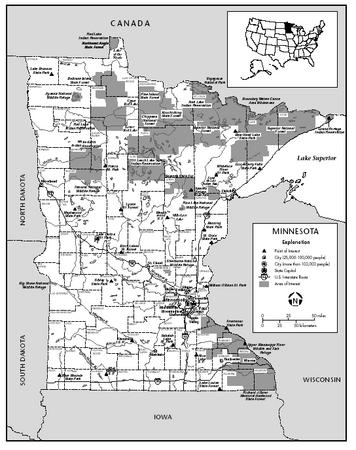Minnesota
Population
Minnesota ranked 21st in population in the US with an estimated total of 5,019,720 in 2002, an increase of 2% since 2000. Between 1990 and 2000, Minnesota's population grew from 4,375,099 to 4,919,479, an increase of 12.4%. The population is projected to reach 5.5 million by 2025. The population density in 2000 was 61.8 persons per sq mi.
Minnesota was still mostly wilderness until a land boom in 1848 attracted the first substantial wave of settlers, mainly lumbermen from New England, farmers from the Middle Atlantic states, and tradespeople from eastern cities. The 1850 census recorded a population of 6,077 in what was then Minnesota Territory. With the signing of major Indian treaties and widespread use of the steamboat, large areas were opened to settlement, and the population exceeded 150,000 by the end of 1857. Attracted by fertile farmland and enticed by ambitious recruitment programs overseas, large numbers of European immigrants came to settle in the new state from the 1860s onward. In 1880, the state population totaled 780,733; by 1920 (when overseas immigration virtually ceased), the state had 2,387,125 residents. Population growth leveled off during the 1920s and has fallen below the national average since the 1940s. As of 2000, Minnesotans had a median age of 35.4 years. Nearly

The Minneapolis–St. Paul metropolitan area had an estimated population of 2,872,109 in 1999, up from an estimated 2,723,137 in 1995. The city of Minneapolis itself had an estimated 375,635 residents in 2002, down from 354,590 in 1994; St. Paul had an estimated 284,037. Other leading cities include Duluth and Rochester.